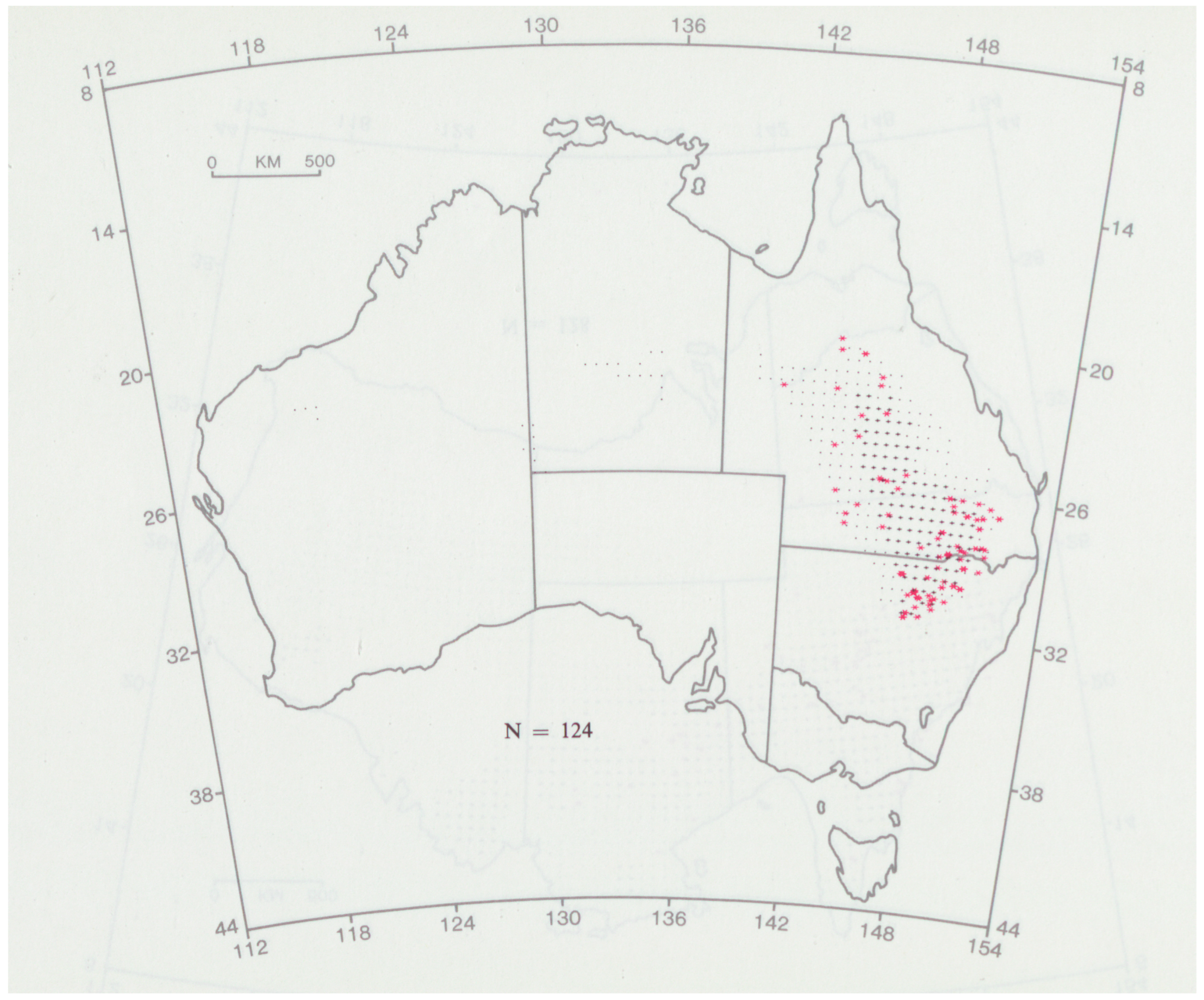The Origins of Modern Species Distribution Modelling: Some Comments on the Vasconcelos et al. (2024) Review
Abstract
Funding
Institutional Review Board Statement
Informed Consent Statement
Data Availability Statement
Acknowledgments
Conflicts of Interest
References
- Vasconcelos, R.N.; Cantillo-Pérez, T.; Franca Rocha, W.J.S.; Aguiar, W.M.; Mendes, G.T.; Bomfim de Jesus, T.; Oliveira de Santana, C.; de Santana, M.M.M.; Oliveira, R.P. Advances and Challenges in Species Ecological Niche Modeling: A Mixed Review. Earth 2024, 5, 963–989. [Google Scholar] [CrossRef]
- Xie, C.; Chen, L.; Li, M.; Jim, C.Y.; Liu, D. BIOCLIM Modeling for Predicting Suitable Habitat for Endangered Tree Tapiscia sinensis (Tapisciaceae) in China. Forests 2023, 14, 2275. [Google Scholar] [CrossRef]
- Moradi, M.; Ashrafzadeh, M.R.; Naghipour, A.A. Comparison of Bioclim, MaxNet and MaxEnt algorithms in predicting the distribution of Caspian snowcock (Tetraogallus caspius) in Iran. J. Nat. Environ. 2024, 77, 163–174. [Google Scholar] [CrossRef]
- Guisan, A.; Thuiller, W.; Zimmermann, N.E. Habitat Suitability and Distribution Models with Applications in R; Cambridge University Press: Cambridge, UK, 2017; p. 20. [Google Scholar] [CrossRef]
- Nix, H.A. A biogeographic analysis of Australian elapid snakes. In Atlas of Elapid Snakes of Australia; Longmore, R., Ed.; Australian Flora and Fauna Series 7; Bureau of Flora and Fauna: Canberra, Australia, 1986; pp. 4–15. Available online: https://ia801408.us.archive.org/25/items/atlaselapidsnak00busb/atlaselapidsnak00busb_bw.pdf (accessed on 17 February 2025).
- Busby, J.R. BIOCLIM—A bioclimate analysis and prediction system. Plant Prot. Q. 1991, 6, 8–9. [Google Scholar]
- Booth, T.H.; Nix, H.A.; Busby, J.R.; Hutchinson, M.F. BIOCLIM: The first species distribution modelling package, its early applications and relevance to most current Maxent studies. Divers. Distrib. 2014, 20, 1–9. [Google Scholar] [CrossRef]
- Hutchinson, M.F. Interpolating mean rainfall using thin plate smoothing splines. Int. J. Geogr. Inf. Syst. 1995, 9, 385–403. [Google Scholar] [CrossRef]
- Booth, T.H. Why understanding the pioneering and continuing contributions of BIOCLIM to species distribution modelling is important. Austral Ecol. 2018, 43, 852–860. [Google Scholar] [CrossRef]
- Hijmans, R.J.; Cameron, S.E.; Parra, J.L.; Jones, P.G.; Jarvis, A. Very high resolution interpolated climate surfaces for global land areas. Int. J. Climatol. 2005, 25, 1965–1978. [Google Scholar] [CrossRef]
- Fick, S.E.; Hijmans, R.J. WorldClim 2: New 1-km spatial resolution climate surfaces for global land areas. Int. J. Climatol. 2017, 37, 4302–4315. [Google Scholar] [CrossRef]
- Hutchinson, M.F.; Nix, H.A.; McMahon, J.P.; Ord, K.D. The development of a topographic and climate database for Africa. In Proceedings of the Third International Conference/Workshop NCGIA, Santa Barbara, CA, USA, 21–26 January 1996; Available online: https://fennerschool.anu.edu.au/research/products/africa-version-2 (accessed on 17 February 2025).
- Bradie, J.; Leung, B. A quantitative synthesis of the importance of variables used in MaxEnt species distribution models. J. Biogeogr. 2017, 44, 1344–1361. [Google Scholar] [CrossRef]
- Elith, J.; Leathwick, J.R. Species distribution models: Ecological explanation and prediction across space and time. Annu. Rev. Ecol. Evol. Syst. 2009, 40, 677–697. [Google Scholar] [CrossRef]
- Busby, J.R. Potential implications of climate change on Australia’s flora and fauna. In Greenhouse: Planning for Climate Change; Pearman, G., Ed.; CSIRO: Melbourne, Australia, 1988; pp. 387–398. [Google Scholar]
- Booth, T.H.; McMurtrie, R.E. Climatic change and Pinus radiata plantations in Australia. In Greenhouse: Planning for Climate Change; Pearman, G., Ed.; CSIRO: Melbourne, Australia, 1988; pp. 534–545. [Google Scholar]
- Booth, T.H. Forestry trials and species adaptability to climate change. Glob. Change Biol. 2024, 30, e17243. [Google Scholar] [CrossRef] [PubMed]
- Title, P.O.; Bemmels, J.B. ENVIREM: An expanded set of bioclimatic and topographic variables increases flexibility and improves performance of ecological niche modelling. Ecography 2018, 41, 291–307. [Google Scholar] [CrossRef]
- Xu, T.; Hutchinson, M.F. ANUCLIM Version 6.1 User Guide; The Australian National University, Fenner School of Environment and Society: Canberra, Australia, 2011; 86p, Available online: https://fennerschool.anu.edu.au/files/anuclim61.pdf (accessed on 17 February 2025).
- Phillips, S.J.; Anderson, R.P.; Schapire, R.E. Maximum entropy modeling of species geographic distributions. Ecol. Model. 2006, 190, 231–259. [Google Scholar] [CrossRef]
- Penman, T.D.; Pike, D.A.; Webb, J.K.; Shine, R. Predicting the impact of climate change on Australia’s most endangered snake, Hoplocephalus bungaroides. Divers. Distrib. 2010, 16, 109–118. [Google Scholar] [CrossRef]
- Dyderski, M.; Paz, S.; Frelich, L.; Jagodzinski, A. How much does climate change threaten European forest tree species distributions? Glob. Change Biol. 2017, 24, 1150–1163. [Google Scholar] [CrossRef] [PubMed]
- Kindt, R. TreeGOER: A database with globally observed environmental ranges for 48,129 tree species. Glob. Change Biol. 2023, 29, 6303–6318. [Google Scholar] [CrossRef] [PubMed]

Disclaimer/Publisher’s Note: The statements, opinions and data contained in all publications are solely those of the individual author(s) and contributor(s) and not of MDPI and/or the editor(s). MDPI and/or the editor(s) disclaim responsibility for any injury to people or property resulting from any ideas, methods, instructions or products referred to in the content. |
© 2025 by the author. Licensee MDPI, Basel, Switzerland. This article is an open access article distributed under the terms and conditions of the Creative Commons Attribution (CC BY) license (https://creativecommons.org/licenses/by/4.0/).
Share and Cite
Booth, T.H. The Origins of Modern Species Distribution Modelling: Some Comments on the Vasconcelos et al. (2024) Review. Earth 2025, 6, 12. https://doi.org/10.3390/earth6010012
Booth TH. The Origins of Modern Species Distribution Modelling: Some Comments on the Vasconcelos et al. (2024) Review. Earth. 2025; 6(1):12. https://doi.org/10.3390/earth6010012
Chicago/Turabian StyleBooth, Trevor H. 2025. "The Origins of Modern Species Distribution Modelling: Some Comments on the Vasconcelos et al. (2024) Review" Earth 6, no. 1: 12. https://doi.org/10.3390/earth6010012
APA StyleBooth, T. H. (2025). The Origins of Modern Species Distribution Modelling: Some Comments on the Vasconcelos et al. (2024) Review. Earth, 6(1), 12. https://doi.org/10.3390/earth6010012





